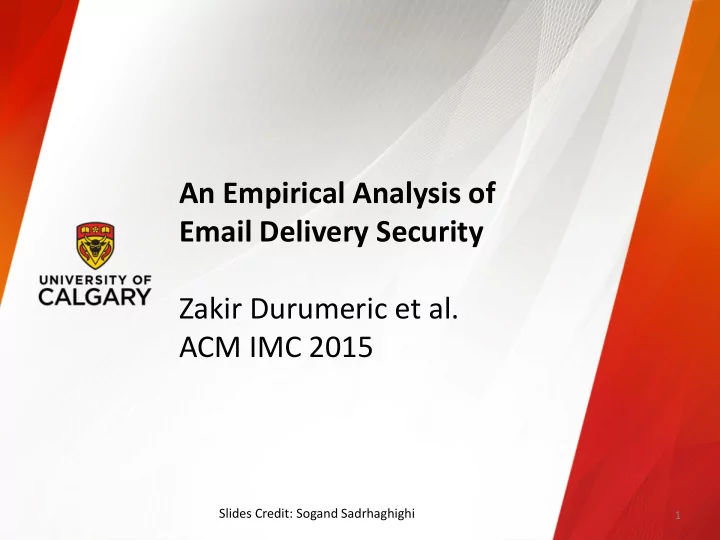

An Empirical Analysis of Email Delivery Security Zakir Durumeric et al. ACM IMC 2015 Slides Credit: Sogand Sadrhaghighi 1
Motivation How is your everyday email protected? 2
SMTP (Simple Mail Transfer Protocol) ▪ SMTP is the Internet standard for sending and relaying email. 3
SMTP Security ▪ The original SMTP (RFC 821) had no built-in security at all. ▪ There have been several security extensions over the years: Confidentiality (encrypt email in transit) 1 STARTTLS Authenticate email on receipt 1 DKIM (Domain Keys Identified Mail) 2 SPF (Sender Policy Framework) DMARC (Domain-based Message 3 Authentication, Reporting + Conformance) Deployment is voluntary and (usually) invisible to end users! 4
Two Empirical Datasets ▪ 16 months of gmail inbound/outbound messages — Longitudinal view: January 2014 to April 2015 — Used Google’s “Transparency Report” for message stats — Also: analysis of ciphers negotiated with SMTP servers ▪ Mail servers from the top 1 million Alexa domains — Snapshot view: current state as of April 2015 — Performed MX lookups in DNS for popular domains — For domains with mail servers (79%), a DNS query was used to identify security extensions supported (if any) — Attempted SMTP/STARTTLS handshake using Zmap 5
STARTTLS: TLS for SMTP ▪ Allows TLS session to be started during an SMTP connection ▪ Mail is transferred over an encrypted session ▪ Protection against passive eavesdroppers 6
STARTTLS: TLS for SMTP Source Destination mail server mail server 7
Empirical Measurements of STARTTLS ▪ Based on the volume of messages protected by STARTTLS ▪ As of April 26, 2015 STARTTLS Initiation Increase from January 2014 Outgoing messages 80% 54% Incoming messages 60% 82% Poodle vulnerability Yahoo and Hotmail deploying STARTTLS Weekends 10% more than weekdays 8
Cipher Suite Analysis Findings: ▪ 80% of outbound connections are protected by TLS ▪ About half of all incoming connections chose a strong cipher suite ▪ About 45% of clients use RC4 despite its known weaknesses 9
Security Threats ▪ STARTTLS provides protection against passive eavesdroppers, but not against active attackers who can tamper with packets ▪ STARTTLS is designed to “ fail open” rather than “ fail closed” (i.e., defaults to plain text if TLS negotiation fails) ▪ An active attacker can manipulate the packets containing STARTTLS to prevent servers from establishing a secure channel! TCP handshake 220 Ready EHLO Client Server XXXX Plain text 10
Geographical Analysis of Active Attacks Cisco exploits this feature to detect spammers and prevent attacks. Downfall: Every email from your country will be in plain text! 11
Authentication ▪ When we receive a message, we want to see if it is sent from someone authorized in the source domain. ▪ Detecting spams SPF (Sender Policy Framework) ▪ Allows a domain to put a DNS TXT record that lists the IP addresses of their legitimate mail servers ▪ Example: <spf- mail.example.com> “v=sfp1 ip4:64.18.0.0/20 - all” 12
DKIM DKIM (Domain Keys Identified Mail ) ▪ The sender publishes its public key in a DNS record ▪ Sender attaches cryptographic signature in a message’s header Signing domain Body hash Digital signature of the content ▪ Recipient checks the signature, using the public key p 13
DMARC ▪ DMARC: Domain-based Message Authentication, Reporting, and Conformance ▪ Builds upon DKIM and SPF ▪ Allows a sender to publishes a mail policy in a DNS record. ▪ Recipient checks for the sender’s policy 14
Empirical Measurements Delivered Gmail Messages Top Million Domains April 2015 15
Conclusions ▪ SMTP by itself is NOT secure ▪ Mail community has started to deploy new security extensions, but progress is slow for small organizations ▪ STARTTLS is not a long-term solution, since active attacks are prevalent and potentially very serious 16
Recommend
More recommend